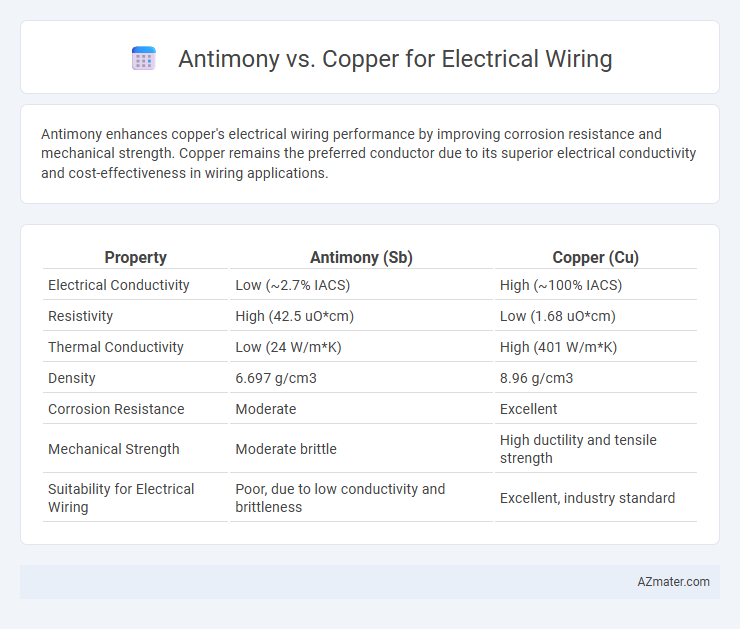Antimony enhances copper's electrical wiring performance by improving corrosion resistance and mechanical strength. Copper remains the preferred conductor due to its superior electrical conductivity and cost-effectiveness in wiring applications.
Table of Comparison
| Property | Antimony (Sb) | Copper (Cu) |
|---|---|---|
| Electrical Conductivity | Low (~2.7% IACS) | High (~100% IACS) |
| Resistivity | High (42.5 uO*cm) | Low (1.68 uO*cm) |
| Thermal Conductivity | Low (24 W/m*K) | High (401 W/m*K) |
| Density | 6.697 g/cm3 | 8.96 g/cm3 |
| Corrosion Resistance | Moderate | Excellent |
| Mechanical Strength | Moderate brittle | High ductility and tensile strength |
| Suitability for Electrical Wiring | Poor, due to low conductivity and brittleness | Excellent, industry standard |
Introduction to Antimony and Copper in Electrical Wiring
Antimony, a metalloid with semiconductor properties, is primarily used in electrical wiring to enhance the strength and durability of copper alloys rather than as a standalone conductor. Copper remains the industry standard in electrical wiring due to its excellent electrical conductivity, thermal stability, and corrosion resistance. Combining antimony with copper alloys improves hardness and mechanical performance while maintaining effective electrical conductivity in wiring applications.
Physical and Chemical Properties: Antimony vs Copper
Antimony is a brittle metalloid with a density of 6.68 g/cm3 and a melting point of 630.63degC, exhibiting poor electrical conductivity and high resistance to corrosion, whereas copper is a highly ductile metal with a density of 8.96 g/cm3, melting point of 1085degC, and excellent electrical conductivity of approximately 5.96 x 10^7 S/m. Copper's superior thermal and electrical conductivity, combined with its chemical stability and oxidation resistance, make it the preferred material for electrical wiring over antimony, which has limited conductivity and mechanical flexibility. Copper also forms a stable oxide layer that protects against further corrosion, whereas antimony's brittle nature reduces its practicality in wiring applications requiring physical durability and consistent conductivity.
Conductivity Comparison: Which Material Performs Better?
Copper exhibits significantly higher electrical conductivity, approximately 97% of the International Annealed Copper Standard (IACS), making it the preferred choice for electrical wiring due to its superior efficiency in conducting electric current. Antimony, primarily used as an alloying element rather than a conductor alone, has much lower conductivity and is not suitable for standalone wiring applications. The superior conductivity and ductility of copper ensure minimal energy loss and enhanced durability in electrical systems compared to antimony-based materials.
Durability and Corrosion Resistance in Wiring Applications
Antimony enhances copper alloys by improving hardness and wear resistance, which increases overall durability in electrical wiring applications. Copper is inherently corrosion-resistant, but the addition of antimony further reduces oxidation and galvanic corrosion, extending the lifespan of wiring in harsh environments. This combination balances electrical conductivity with superior mechanical properties, making antimony-infused copper alloys ideal for long-lasting, reliable electrical wiring installations.
Cost Analysis: Antimony vs Copper for Electrical Projects
Antimony, primarily used as an alloying element rather than a primary conductor, incurs higher costs due to its limited electrical conductivity and specialized applications, making it less cost-effective than copper for electrical wiring. Copper remains the preferred choice because of its superior electrical conductivity, widespread availability, and competitive price per pound, which ensures better overall cost efficiency in electrical projects. The price volatility of antimony, driven by supply constraints, further increases its cost risk compared to stable copper market prices, positioning copper as the economical option for large-scale wiring installations.
Flexibility and Ease of Installation
Copper wiring is highly favored for electrical installations due to its superior flexibility and ease of handling, allowing electricians to bend and route cables efficiently around obstacles. Antimony, typically used as an alloying element rather than a primary conductor, lacks the ductility of copper, making it less suitable for flexible wiring applications. The intrinsic malleability of copper reduces installation time and labor costs, positioning it as the preferred choice for residential and commercial electrical wiring projects.
Safety Considerations: Toxicity and Fire Resistance
Antimony, used as a flame retardant in some wiring insulation, enhances fire resistance, reducing the risk of electrical fires compared to copper wiring alone. Copper wires, while excellent conductors with low toxicity, pose minimal safety risks but lack inherent fire-resistant properties, necessitating protective insulation. Handling antimony requires caution due to its potential toxicity in dust or fumes, making copper wiring safer for direct contact and common household use.
Environmental Impact and Sustainability
Copper, widely used in electrical wiring, is highly recyclable with a global recycling rate exceeding 50%, reducing mining impacts and conserving natural resources. Antimony, often used as a flame-retardant additive in wiring insulation, poses environmental concerns due to its toxicity and limited recycling options, leading to potential soil and water contamination. Choosing copper wiring supports sustainability through extensive reuse and lower environmental footprint, while the reliance on antimony raises challenges in eco-friendly disposal and long-term ecological safety.
Common Uses and Industry Preferences
Copper is the preferred choice for electrical wiring due to its superior electrical conductivity, corrosion resistance, and ductility, making it ideal for residential, commercial, and industrial applications. Antimony is rarely used alone in wiring but serves as an important alloying element in lead-based solders and some cable sheathing to enhance strength and durability. The electrical industry favors copper for its efficiency and reliability, while antimony's role remains largely supplementary in specialized components.
Future Trends in Electrical Wiring Materials
Antimony-enhanced copper alloys are gaining traction in electrical wiring due to their improved mechanical strength and corrosion resistance, addressing the limitations of pure copper. Emerging trends indicate a shift toward composite materials incorporating antimony to enhance conductivity and durability in harsh environments, benefiting industries like aerospace and renewable energy. Advances in nanotechnology and material science are expected to further optimize these alloys, reducing weight and increasing efficiency in future electrical wiring applications.

Infographic: Antimony vs Copper for Electrical Wiring
 azmater.com
azmater.com